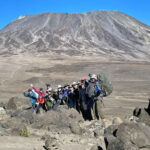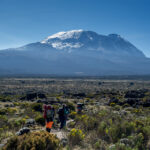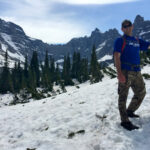Amy just returned from her successful Kili trek in November, and she attributes some of her success to a basic (but often ignored) tip:
Don’t overpack.
On most trips, it’s just an inconvenience, but on the mountain, where there’s a strict 33-pound weight limit, every item matters. And trust us: you’ll regret every extra ounce once you’re getting close to the summit.
So when you’re packing for your trek, follow our expert advice:
–
Before You Go: Weigh Everything (and Pull Out All the Extras)
We offer trekkers a gear list (in your Prep Guide) that’s comprehensive; one of the items on that list is a 155-liter duffle.
The short story: if you’re getting even close to filling that duffle, you’re overpacking. Think of packing for Kili as a four-step process:
1.) Set out everything you’ll need for your trek.
2.) Pull out items you’ll be wearing daily, since they won’t go towards your weight limit (this includes boots, trekking poles, gaiters, base layer, hat, and sunglasses).
3.) Next, pull out items that you’ll keep in your day pack the entire time (e.g., your camera, chapstick, sunscreen, toilet paper and/or baby wipes, personal first aid kit, and rain gear).
4.) Weigh the remaining items in the duffle bag (either on a floor scale or with a travel hand scale). Be sure to add the weight of items you plan to rent (approximate weights are included on your rental forms).
If you’re following Thomson’s packing list, you should be well within the weight limit. Follow a similar procedure for your safari duffle, which should be 30-40 liters, soft-sided (without wheels or a hard frame), and should not exceed 33 pounds fully packed (the internal-flight weight limit in Tanzania).
Good packers should have enough room in their larger duffle to hold their fully-packed safari duffle (you can then check only the larger bag on your international flight). When you arrive, simply pull out this duffle and leave it at our Arusha office during your trek.
Expert Tips:
* When packing and weighing your safari duffle, make sure to include items you plan to use for both legs of your trip, such as personal toiletries or a lightweight fleece.
* You won’t need items like a hairdryer (which won’t work with Tanzanian outlets at any point during the trip), and shouldn’t bring along high-value items or items that would be difficult to replace, such as a sentimental piece of jewelry.
–
During Your Trip: Organizing and Repacking
Each morning on your trek, you’ll pull out the gear best suited to that day (and quarantine the stinky socks from the day before). That’s why few things will be as important as stuff sacks in keeping your luggage organized, easy to access, and under control.
Your day pack contents will change daily. In addition to your first aid kit, personal effects, sun and fleece hat, and rain gear, your day pack should always include layers you’ll need for potential weather changes (in case temperatures drop rapidly on the trail). In order to make this as simple as possible:
1.) Pack several different sizes of bags, ranging from pint-sized to 3XL.
2.) Smaller bags are for packing out waste on the trail, organizing, and keeping dirty laundry separated.
3.) Larger bags can organize gear by layer (i.e., base, middle, or outer), making it easy to find the right gear for any elevation/weather.
4.) A compression sack for your sleeping bag (which you’ll pack in camp duffle each morning).
Expert Tips:
* Your sleeping bag, inflatable mat, camp shoes, toiletries, extra layers, headlamp, and anything else not necessary to that day’s trek will be in your camp duffle; make sure to pull anything you need into your daypack before leaving camp.
* Packing a small bag with ‘every day’ toiletries—like toothpaste and toothbrush—inside a larger bag with all toiletries, will make it easy to pull out the things you’ll need often.
After Your Trek
If you’re heading home after your trek, you’ll have repacked on the mountain, but if you’re continuing on a safari or another extension, it’s important to remember:
1.) When you’re picked up on Kili, your stored bag will be in the car and accompany you to your lodge or day room.
2.) You can store one bag at the Arusha offices at any given time; this means that during your Kili trek your safari bag (or a set of clean travel clothing) can stay there, and if you continue on safari, your trekking bag can stay there.
3.) Make sure to shuffle your gear as needed. Move unnecessary items from your daypack to your Kili duffle, and remember to move any gear you intended to use for both legs of your adventure from your Kili duffle into your safari duffle.
Follow these tips, and your luggage should be the last thing you have to worry about on the mountain…which is good, since you ought to be focusing on reaching the summit!






